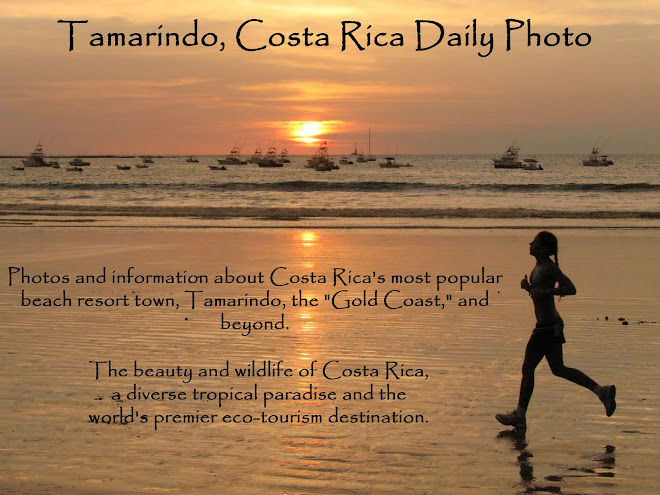 This sail boat makes nightly sunset cruises from Tamarindo. The views from the water of the town, beaches, shoreline, and surrounding hills in the late afternoon light are delightful.
This sail boat makes nightly sunset cruises from Tamarindo. The views from the water of the town, beaches, shoreline, and surrounding hills in the late afternoon light are delightful.The staff serves a variety of food and drink, including slices of fresh fruit that are refreshing on a warm day. (And, yes, tourists from the USA and Canada can eat fresh fruit and drink tap water in Costa Rica with no problems. Costa Rica also uses the same electricity as the USA.)
My wife and I have taken this a sunset cruise, and if you are wondering whether there was there a sunset, please check tomorrow's photo.
The scene of a sailboat on the Costa Rican coast gives me an excuse to talk about the history of Costa Rica, which of course included the exploration and settlement of Costa Rica by Spanish sailing the coast. Columbus visited Costa Rica on his fourth voyage and spent 17 days on the Caribbean coast. (The Caribbean coast is quite different than the Pacific coast.) He made reports of natives wearing gold and silver, which of course prompted further Spanish expeditions, beginning with an unsuccessful attempt to establish a settlement in 1506.
A second attempt at colonization was made in 1522, this time on the Pacific coast. The gold possessed by the native population caused the expedition leader, Gil Gonzalez Davila, to give the area the name la costa rica, or "rich coast." The first permanent settlement in the country was on the Pacific coast in 1524. The indigenous people's gold, however, came from elsewhere and the Spanish did not find a significant source of local gold in Costa Rica. As a result, they enslaved some of the indigenous people to send them off to work in the gold and silver mines of Peru and Mexico, disease decimated the local population, and the Spanish generally overlooked the area for the next 250 years.
I will find an excuse in later posts to talk about later Costa Rican history, which includes independence from Spain, the decision of the Guanacaste region to join Costa Rica rather than Nicaragua, the resistance to an invasion by an army from the USA in the 1850's, and more contemporary events.
A major event was the country's decision in the late 1940's to discontinue its military and invest its funds in education and health care instead. Costa Rica has been a stable beacon of democracy in Central America, and its current President, Oscar Arias, won the Nobel Peace Prize due to his peace-maker role for the Nicaraguan conflict during his earlier term as President in the 1980's.

Such an interesting post again. A histoey and environmental lesson. I must get more people to read your blog. Lovely image today.
ReplyDeleteThat must really have been delightful, given the beauty of the shoreline. Saw your sunset photo too—gorgeous!
ReplyDelete